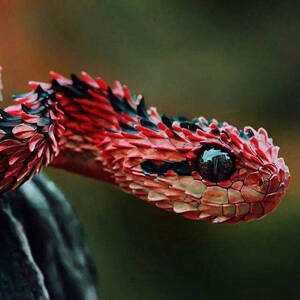Chlamydosaurus kingii
IUCN
LCBasic Information
Scientific classification
- name:Chlamydosaurus kingii
- Scientific Name:Frilled lizard, cloaked lizard, frilled lizard, Australian cloaked lizard, pleated lizard, wrinkled lizard
- Outline:Squamata
- Family:Squamata Iguania Agamidae Chlamydosaurus
Vital signs
- length:85cm
- Weight:Male about 780g, female about 400g
- lifetime:10 year
Feature
When meeting an enemy, hold up an umbrella to intimidate them. If they fail to scare them, stand upright and run away.
Distribution and Habitat
It is mainly distributed in northern Australia and southern New Guinea, and likes to live in dry grasslands, bushes and woods.
Appearance
The body length of the umbrella lizard is 60-100 cm, 0.5-1 kg. It has a long and thin tail, which accounts for 2/3 of its body length. The neck is surrounded by an umbrella-shaped collar membrane supported by the hyoid bone. Its color is dazzling and bright. When encountering an external enemy, it will instantly open its unique collar and open its mouth wide, which is very deterrent. The collar of the juvenile is small and becomes larger as it grows.
The umbrella lizard is a medium-to-large lizard. The body color ranges from brown to brown to gray and even black, mostly regional changes. It is not easy to distinguish between males and females, especially in the juvenile stage. Generally speaking, the adult male is much larger than the female, with a larger head and collar, a slender tail, and a bulge under the cloaca. The body color is brighter and the sex is milder.
The body is slightly flat and covered with fine scales. Not only can it stand on its hind legs, with its forelimbs
Details
The frilled lizard comes from the coastal areas of southern New Guinea and northern Australia. It is a well-known medium-to-large lizard and the second largest lizard in the family Iguanidae (the largest is the spotted sail lizard). There are obvious differences in body size and color between the two frilled lizards from different origins. The frilled lizards native to Australia are larger in size and brownish red in color. The frilled lizards native to Indonesia are slightly smaller in size and grayish white in color. The most common ones on the market are from Indonesia.

Most of the time, it is in the trees, and it also hunts on the ground. The body can run upright, usually walking on four legs, and using the hind legs when running away. When it is angry, the wrinkles stand up and the mouth opens wide, as if the head has suddenly expanded several times to scare off the opponent. It will be more active during the rainy season.
Flying lizards are actually very docile and lively. "Opening the umbrella" and opening the mouth to scare the opponent is already their strongest attack. The next step is often to run away.
Wild flying lizards are protected animals and cannot be kept as pets. However, flying lizards can be artificially bred at present, and artificially bred flying lizards can be kept. It has a gentle and lively temperament and is a very suitable lizard species as a pet. Of course, flying lizards are definitely not a novice reptile pet, and the difficulty of keeping them is medium.
Flying lizards have many natural enemies in their native habitats, such as eagles, owls, large lizards, and snakes. They will prey on them. During the dry season, the frilled lizard curls up in a tall tree hole and begins to hibernate until the humid weather returns.
Listed in the 2010 Red List of Threatened Species of the World Conservation Union (IUCN) ver 3.1-Least Concern (LC).
Protect wildlife and eliminate game.
Maintaining ecological balance is everyone's responsibility!








